Titanium Mouths

In an age of innovation, implants are increasingly common in dental surgery. Titanium is used as this material does not generate rejection. Implants can replace teeth or help attach fixed bridges. From this point of view, certainly, implants are the most suitable solution to repair teeth.
However, implant placement has or has so far had disadvantages. On the one hand, the disadvantage of time, since until now only an implant was made until the screw was placed and the fixed tooth was placed, since it took at least three months. On the other hand, there is a pocket, and in that sense it is evident that implants are very expensive, much more than conventional bridges or artificial dentures. Finally, when the surgery is involved, it is necessary to take into account the problems that may arise in any operation.
The recent invention of the implant system has given a solution to the disadvantage of time and not in any way, since in a single day all the lower teeth can be placed.
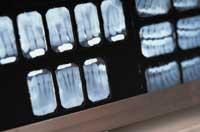
The key to accelerating the process is independent of the osteointegration capability between titanium and tissue, as are individual implants. The key is the structures designed for use in this system and the process used for its implementation. As for monetary accounts, there is no change, because there are months in which all teeth are placed one by one or in a single day is paid equal.
Preoperative
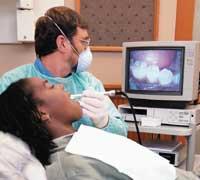
The implantation system in a single day is called Novum, the latest novelty of the Branemark osseointegration system. However, the new system is not available to anyone. The jaw should have minimum dimensions, a height of 12-13 millimeters and a width of 6-7 millimeters. In addition, the patient must be in good health as he faces a two-hour operation. As
in regular operations, the decision to access the operating room is usually preceded by a series of tests, regular clinical studies and x-rays.
The intervention is that the patient remains awake, but with sedation, that is, he is able to “open his mouth”, obey orders like “close his mouth” and answer questions like “Do you have pain?”, but he does not feel pain, since with sedation his mouth is squeezed with conventional anesthesia.
It is 8 in the morning. The patient is already in the operating room with sedation. The intervention begins with the enlargement of the teeth. In most cases, people who need implants have neither teeth nor teeth, but in some cases they may have them, so before opening the gum, you need to remove teeth and teeth.
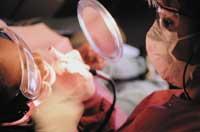
Once the teeth are opened, the alveolar crowning of the jaw is wiped. For this task they use grinding mills or forceps. It can be said that the work is the most mechanical, although with great precision. With the use of these devices, working in continuous irrigation with a saline solution, leave the alveoli height equal to reach a width of 6-7 millimeters. After leaving the high alveolar of the jaw with the right width, the area of the mouth, prepared for work, begins the work of placing implants.
Original implants “Inasmet”
If the Novum implant system is a great innovation, the Inasmet technology center in San Sebastian and Miguel A. Dr. De Maeztu's new implant prosthesis system is no less. The new system has significantly improved the osseointegration of prostheses used in implants.
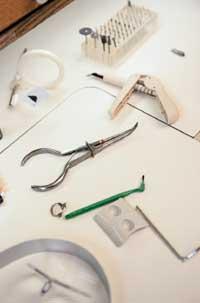
Osteointegration is the link between the bone and the implant, which ensures the absence of movement in the bone. To achieve this, when the bone grows, it undergoes a rodeo action of the implant. However, this does not happen with all patients, as they usually have discomfort of osteoporosis, lack of bones, etc.
In fact, the system patented by Inasmet and Dr. Maeztu has avoided these problems in the bonding of the implant with the bone. The new system uses particle beams, ion beams. Since this process does not introduce foreign substances into the body that prevent it, the process can be considered biocompatible.
At the moment, the new system will be used in dental implants, but at the moment it is being investigated whether it can be used in other bone implants such as knee prosthesis, hip prosthesis, etc.
The project has lasted six years, and Inasmet has worked jointly with the University of the Basque Country, Osakidetza and the General Council of Stomatologists and Dentists of Spain.
Structure to structure
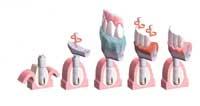
As mentioned above, the main novelty of this system is in the structures that have been invented for implantation of implants. A total of four types of templates are used in the process.
Work begins when the guide template is placed over the jaw. Since this template has a width of 6 millimeters, you can check whether the base of the previously created alveolar is suitable or not. The template consists of 3 holes to mark the fixing points on which the links will be placed.

The marking phase part of the central hole of the template with the guide cutter. Once the three marks are made, with the 2 mm helical cutter, the holes are made. Once the perforations are made, using the guide template, the guide pins are placed, first in the central hole and then on the sides. These pins are very useful because they have 2 millimeters in the part that is inserted inside the bone and 5 millimeters in the part that does not enter. This allows you to know how much bone to eat when using strawberry.
Once the PINs are placed, the validation template work begins. This template is used to verify that the holes made are correctly made.
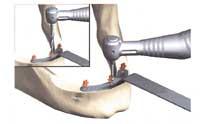
The validation template replaces the guide pins. If these pins come in with ease, it indicates that the work is well done, if it is difficult to put in, you will have to make adjustments. If, after adapting, the placement of the PINs is still complicated, the process must begin again with the conductive cutter. Once the correct position of the three holes is obtained, the location template is used. It is placed in the jaw and in the two lateral holes the guide pins are placed.

This template is used to prepare the central hole with special strawberries (between 3 and 4.4 millimeters) and milling templates (between 2 and 5 millimeters). The milling machine templates are placed in the location template with one side in the jaw hole and the other in the template handle. Then work with the strawberries, from the smallest to the largest, to place the central link. Once the link is placed, the location template is removed and the work of another template, the V template, begins.
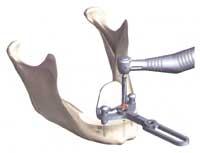
The V template is used to place side links. It is fastened by a provisional screw to the central link. Then, with the help of the guide pin, the V-type template is placed over the jaw socket. As has been done before, when working with strawberries of different sizes the lateral joints are placed. Once placed the template type V is removed and the links are checked correctly. If the three links are well placed, the underlying and superior prosthetic structures, previously performed and the main novelty of this system, are tested with three links to check that the links are in the right place and shape.
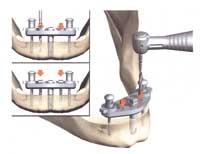
If everything is fine, the surgeon's work may end. The previous titanium bottom structure is placed on three links. This lower structure is linked with the first provisional screws to improve the connection between the joints and the lower structure. Subsequently, with other screws, they definitely attach the lower structure.
With this last step the surgeon's work has ended. Take over the prosthetic. The lower and upper structures join together. As it is prefabricated parts there is no problem to fit them correctly. Once the two are linked, with the silicone paste, the wax, the measurements of the jaw are taken so that the prosthesis is performed correctly.
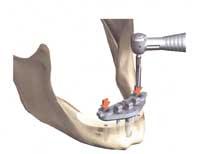
The superior structure of titanium is released and, together with the measures taken with silicone, is sent to the laboratory where they have to perform a real prosthesis. It is already noon, the patient can rest until evening.
Prosthetics in record time
After receiving the intervened wax mold and the piece that will support the upper structure, the prosthesis begins to work. From the vacuum and in a few hours must perform a complete prosthesis.

Unlike other fixed and mobile prostheses, now all parts are manufactured in advance. This method advances a lot of time and the patient should not use another prosthesis until he finishes his own. The patient, accompanied by the dentist, chooses the size and appearance of the new teeth, as well as the color.
The prosthetic binds all the pieces of the lower line of the tile into the upper structure and fixes them with wax, even if a change is necessary. With the help of the articulator, all jaw movements are configured to see that all movements can be performed correctly. In some cases the patient uses mobile prostheses from the upper part and the same prosthesis will be used in the articulator.
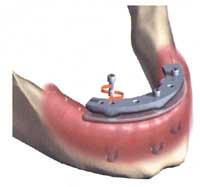
After hardening the wax on a machine for an hour, the test assembly is finished. With this assembly the patient should be asked to test the soft prosthesis and obtain his approval. The prosthetic returns to his work to prepare the final prosthesis, but this time he uses a hard paste. Remove this second with a mold to the wax prosthesis.
The prosthesis must be reassembled in the upper structure and left to dry. The entire process has taken about five hours. The top structure should now be boxed and taken to the clinic. There, using four small screws, it joins the titanium structures previously placed.
They are around 6 pm and the patient has new teeth. You can go home. You will have to come back a week and check if everything is fine. So, you will have to return two or three weeks later, six months later and in the end you will only have to carry out the annual reviews.
Possible risks of treatment

Jaw break. If the bone is too milled, a break in the jaw may occur. Classic implants should be performed if they occur.
Bleeding. If holes are misplaced to place joints, bloodshed can occur.
Instability of links. Due to bone characteristics, excessive compression of joints or poor hole work, joints may be unstable. To solve the problem you can reduce the height of the jaw or perform the classic implant.

Bone heating. Excessive pressure with strawberries or low watering of the mouth during the use of strawberries can cause bone deterioration. With the Novum technique the chances of bone deterioration are greater than conventional ones, since the joints are large. To avoid the problem, carefully milling should be accompanied by continuous irrigation of the work area.
Deterioration of nerves. Links are positioned using templates. There is always a risk of putting some template wrong and so you can damage any of the nerves. In order for this not to happen, all measures must be taken correctly.
Component breakage. Breaking new components is not easy, but it can happen. Gentle surgical techniques are recommended to reduce risk.
Deterioration of joints. If the whole process goes well, it wouldn't be very normal. But at some point – with a blow, with some clumsy notch... – some be broken. There is no choice but to establish new links.





